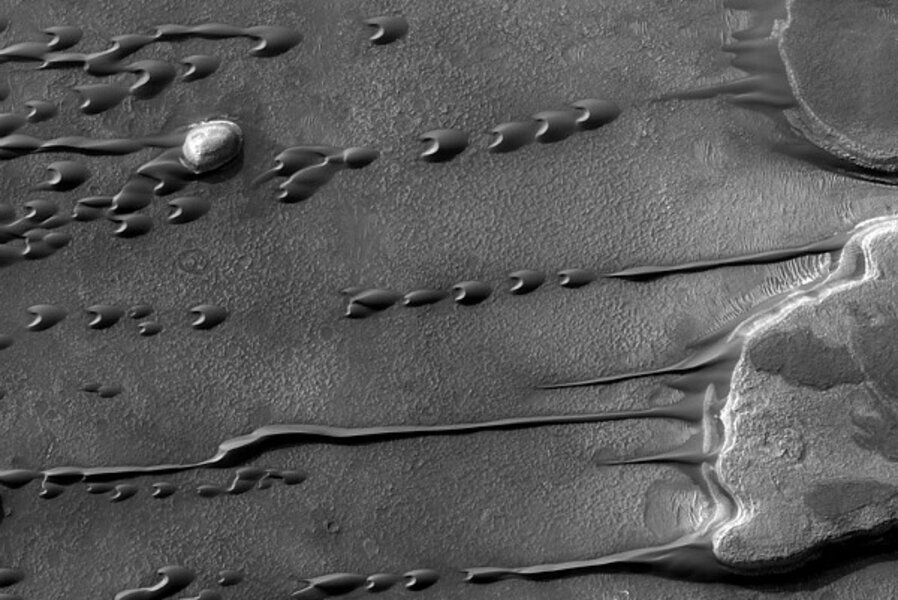Mars sand dunes may hint at water beneath
Loading...
Shifting dunes on Mars, especially those near the planet's north pole, may harbor layers of liquid water not far beneath their ice-encrusted surfaces.
That is the implication of studies of sand dunes in Alaska's Kobuk Valley National Park, some 380 miles northwest of Fairbanks. There, above the Arctic Circle, researchers using the dunes as stand-ins for dunes on Mars have found evidence for liquid water trapped between the dunes' icy winter coat and subsurface layers of ice or freeze-dried silt that form a temporary, cement-like barrier that prevents the water from percolating deeper into the dune.
The water remains liquid because it exists in an environment of temperature and pressure that allows liquid water, ice, and water vapor to exist side by side.
The discovery of this seasonal mechanism for storing liquid water on Mars-like features at Mars-like temperatures opens a window on processes that could have been at play early in Mars' history, when it hosted an environment that could have harbored microbial life.
And it could help explain debris flows scientists have spotted on sunlit sections of crater and canyon walls in various locations around the planet.
"Mars has likely had active sand dunes during every geologic era, and some of these eras were warmer and wetter than Mars is today," notes Cynthia Dinwiddie, a researcher with the Southwest Research Institute in Boulder, Colo.
"There is some possibility that equivalent processes are currently occurring on Mars," primarily in dune fields in Mars' equivalent of the Arctic, she writes in an email. Still, "the likelihood is even greater that equivalent processes occurred on ancient Mars."
The dune field in Alaska that Dr. Dinwiddie and Southwest Research Institute colleague Don Hooper study sits on the boundary between boreal forests to the south and Arctic tundra to the north. Known as the Great Kobuk Sand Dune field, the sands were first formed during ice ages that occurred between 300,000 and 130,000 years ago.
Glaciers sculpted the Brooks Range to the north and left the sandy debris in the Kobuk River Valley. There, wind, meltwater, and more-recent ice ages would continue to rework the material to leave some 24 square miles of mobile dunes on the surface and another 250 square miles of sandy soils that don't get around much anymore.
NASA's small squadron of Mars orbiters revealed dunes in the planet's north polar regions, and they took enough images over a sufficient period of time to reveal that the dunes moved. But the pace was glacial, especially when compared with the movement of dunes in locations such as the Sahara Desert or the US Southwest.
Dinwiddie and colleagues looked to the Great Kobuk Sand Dune field for possible answers as to why Mars' polar dunes were such geophysical sloths – first exploring the Alaskan analogues via satellite remote-sensing, then in 2010, with a field trip in March, while temperatures still averaged about 5.5 degrees Fahrenheit and the dunes' top, mobile layer was still frozen solid.
During the field trip, the researchers noticed water coming up through the bore holes they had drilled but that had not yet reached deep into the dunes to tap the region's aquifer. Ground-penetrating radar and measurements of the ground's electrical resistance revealed evidence for a layer of liquid water just below the frozen mobile layer.
As if to ice the cake, the team found water seeping out of mini bluffs where erosion or slumping exposed this layer to the increasing warmth of a March sun. They also found debris flows, which appeared to signaled brief bouts of melting from this layer.
Intriguingly, climate conditions for the Great Kobuk Sand Dune field in March are similar to the conditions NASA's Mars Rover Curiosity is experiencing at Gale Crater – which also has dunes. They migrate at a lethargic pace comparable to Alaska's dunes. But they don't get the seasonal frost cover that Alaska's or Mars' polar dunes do.
At the least, the mechanism generating the debris flows on Alaska's dunes could help explain seasonal debris flows researchers have detected on Mars, notes Dr. Hooper.
Since the first evidence for these flows was reported 13 years ago, researchers have debated the triggers. Some argue that they merely represent an avalanche of sediment that the slopes no longer could support. Others have suggested they are triggered by sudden outbursts from buried CO2 ice that rapidly turns to gas and punches through the soil and rock on slopes when sunlight warms them. Or they could result from the sudden release of water as the sunlit warmth of surrounding soils melts enough ice to trigger a large flow before the water quickly evaporates.
Flows that researchers have seen on the walls of Martian craters appear and disappear with the warm season, Dr. Hooper notes, just as "flow features commonly form under seasonally warming conditions" at the Great Kobuk Sand Dunes.
"By studying cold-climate dune fields on Earth, we will achieve a greater understanding of the full spectrum of possible origins for Martian gully systems," he writes in an email.
"Martian debris flows and their associated gullies are believed to be youthful geologic features," he adds. They serve as "a reminder that Mars is not a dead planet but still has active surface processes."






